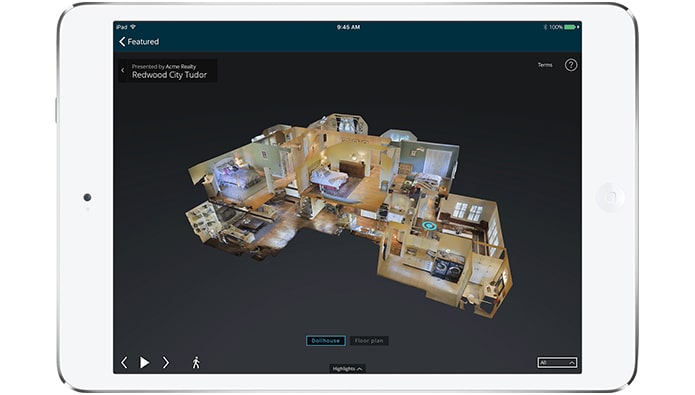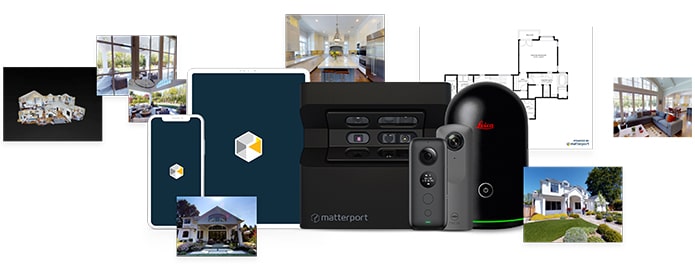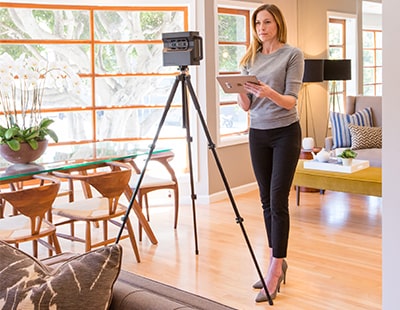These developments come against a backdrop of continued Brexit uncertainty in the housing market and an extremely competitive market, which is driving agents to embrace new technology more than ever before.
This year Matterport took virtual tours one step further, launching Cloud 3.0, an Artificial Intelligence-powered (AI) platform that allows users to create engaging 3D tours with cameras such as the Ricoh Theta V and Insta360™ ONE X, democratising the power of immersive technology.
The AI technology behind the software improves accuracy to within 5%, removing human error and freeing up time for agents to secure new business and close deals.
This low cost of entry technology will for the first time allow any agent to create their own virtual tours for almost any property, making the technology available to all, democratising the world off immersive media tours.
High quality 3D virtual tours are set to become mainstream in estate agency in 2019.
Why are agents using 3D tours?
We know from our research with Foxtons that when viewing a property online, buyers decide within just eight minutes if they will arrange a viewing. Over 75% of house hunters also said they were irritated with properties that did not match up to their online listing.
Online presence and the listings themselves are therefore vital in securing the meaningful interest that could result in a sale. Prospective buyers are more likely to trust a 3D tour that they can navigate themselves, which have true-to-life representation, rather than a series of traditional images or a video created by the agent.

They get a real sense of the space within a property, and emotional connection, so they can determine whether it is the right home.
The data is compelling. Virtual tours can help properties to sell five times faster than traditional imagery. Properties listed with 3D walkthroughs can also achieve as many as four times the number of enquiries and generate 49% more leads.
Online vs the high street
The estate agency market has seen significant disruption in recent years, as traditional high street agents have faced competition from cheaper online and hybrid models.
High street agents are fighting back, using technology such as 3D tours to strengthen their traditional appeal.
In a branch, one of the advantages of 3D tours is that they allow prospective viewers to look through properties virtually with the agent and then decide which ones to see in person.
This is not only a much more efficient way of managing viewings, but also gives the agent a platform to focus on selling the best features of the property.
In an age where the traditional agent is looking for new ways in which to engage and advise buyers, demonstrating their value versus online rivals, virtual tours are a powerful tool that delivers greater engagement digitally.
In the past year online agents have suffered a number high-profile setbacks, with Emoov collapsing into administration and Purplebricks experiencing a significant fall in its share price.
Online agents’ claim to be digitally disruptive will increasingly depend not just on their lack of a branch, but their ability to use technology to sell properties.
Both traditional and online agents are looking for new ways in which they can add value to the client experience, and better, smarter use of technology is undoubtedly a powerful way of enhancing both models.
AI will continue to transform virtual tours
AI will continue to enhance the quality and accessibility of 3D tours. One way this will happen is by allowing creators of 3D tours to benefit from the many thousands of 3D captures taken by others.
Matterport has the world’s largest library of 3D space data, with customers producing over 1.5 million cloud-hosted 3D interior-spaces in 100 countries.

The technology is built on Matterport’s worldwide dataset comprising billions of 3D data points. This allows Matterport to create true 3D tours constructed from 2D images. The machine learning and 3D intelligence, powered by Matterport’s Cortext technology is a game-changer for the industry.
While virtual tours have been on the market for some time, none have the true-to-life clarity of Matterport, the technology creates actual 3D content allowing users to walk through the tours as if they are actually there.
The machine learning and 3D intelligence can understand objects, rooms and detailed characteristics in a way that has not previously been possible - creating a new generation of virtual tours.
This entirely new category of immersive media will empower agents, enabling them to drive viewings and win listings.
As this technology continues to develop, agents will benefit from even more accessible and accurate tours and 3D experiences. As AI technology makes 3D tours cheaper and easier to make than ever before, it is inevitable that their use will increase in 2019.
*James Morris-Manuel is VP EMEA for Matterport
























Join the conversation
Be the first to comment (please use the comment box below)
Please login to comment